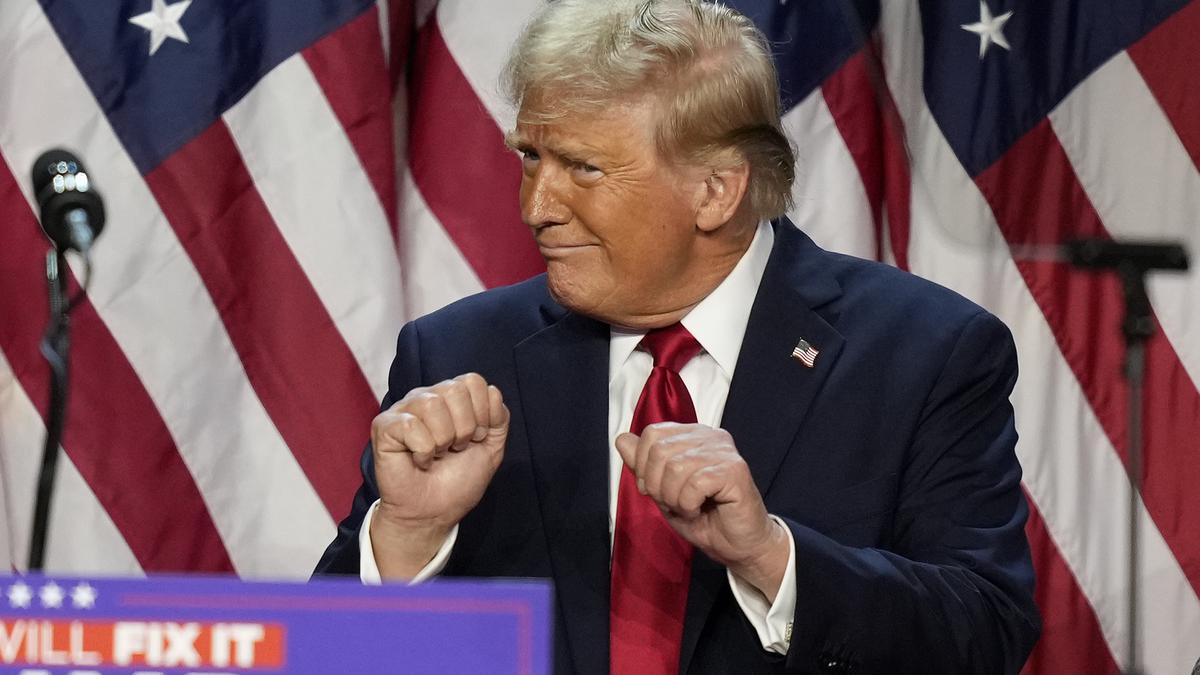
Former President Donald Trump dances after speaking at an Election Night Watch party on November 6, 2024 in West Palm Beach, Florida. , Photo Credit: AP
TeaThe return of Donald Trump as president of the world’s largest economy, which accounts for more than a quarter of global GDP, could mean a number of changes, some of which could be detrimental, for many major economies, including India. Can. This would mean a return to escalating trade wars; continuation of economic protectionism; ending multilateralism; and imposing restrictions on immigration to the US, which could hamper India’s IT services sector.
America is India’s second largest trading partner, with a share of $118.3 billion. But, to Mr Trump’s dismay, it is the only country with a trade surplus ($36.74 billion in the same period) among India’s top five trading partners.
US Election 2024 Results | live update
While the US counts India among its top 10 trading partners, its share in total exports to India is less than 3%. More importantly, the US remains the largest source of foreign direct investment for India ($103 billion in the last financial year).
These numbers have now become important with the return of Mr Trump, as fears have resurfaced over his focus on bilateral trade and sidelining agreements made through the World Trade Organization (WTO), as in 2018. Unilateral imposition of import duty on aluminum and steel. Which had an impact on many countries including India. While India attempted to retaliate with higher tariffs on agricultural products such as apples and walnuts in 2019, it did not follow through on its threat.
During his election campaigns, Mr Trump called India a “major abuser” of trade relations. In his first term, he took steps ranging from a complete ban on both China and India to continuously increasing tariffs on many goods. A major confrontation with China occurred when it banned Huawei’s 5G mobile devices in 2018. It also asked its NATO allies to follow suit, while its policies towards Western partners became negative.
Mr Trump’s ‘America First’ campaign calls for escalating such trade wars with its allies and adversaries. Their proposal to impose a 10% tax on all imports and a 60% tax on Chinese-made products will have an inflationary impact around the world. This follows the Federal Reserve cutting rates by 50 basis points on September 18, the first in four years, as inflation eases and the job market in the US begins to cool. Mr Trump’s proposed tariffs would likely be passed on to consumers, triggering withdrawals. Causing high inflation domestically and similar pressures globally. Price increases in the US will spill over into global supply chains as the US accounts for a large share of exports of top technology and agricultural products.
The biggest impact will likely be on China, which has been America’s largest trading partner for decades, with a surplus of more than $380 billion in 2022, according to the Office of the U.S. Trade Representative. It’s a surplus that Mr. Trump will move quickly to close, but he will do so at a time when the Chinese economy is struggling with the bottoming out of its property market and a general decline in growth, leading to losses for the People’s Bank. It has happened. China recently cut interest rates in September to increase liquidity and support lending.
China is already looking at other markets for its exports, but it faces stiff opposition for many of its products, such as electric vehicles in the EU and iron and steel in India.
For India, Mr Trump’s return could impact a range of products from generic medicines to IT services. A key concern will be a return to restrictions on highly skilled workers, or the H1B and L1 visa programs that Mr Trump implemented in his first term. The denial rate for Indian IT professionals seeking H1B visas increased under Mr Trump’s administration, leading companies like Infosys to hire nearly 10,0000 US workers. While Infosys called it a “strategic human asset investment”, it was clear that it was triggered by efforts by the US government to tighten immigration.
Mr Trump has also promised to increase oil and natural gas drilling, which would mean the US would once again fall behind on its climate goals. It will also likely lead to changes in global supply chains as the EU continues efforts to move away from reliance on Russian LNG, which has already declined from 40% in 2019 to 15% in 2024. Over the same period, the US share has increased to 46. % of EU natural gas supply. It will be interesting to see how Mr. Trump interacts with the EU’s carbon border adjustment mechanism, which seeks to reduce the carbon footprint of EU imports, as the US under his administration has seen a decline in fossil-fuel based power generation and Can return to production processes.
kunal.shankar@thehindu.co.in
published – November 07, 2024 12:55 am IST
